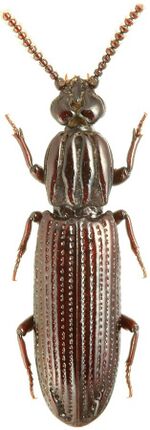Biology:Rhysodinae
| Rhysodinae | |
|---|---|

| |
| Omoglymmius americanus | |
| Scientific classification | |
| Domain: | Eukaryota |
| Kingdom: | Animalia |
| Phylum: | Arthropoda |
| Class: | Insecta |
| Order: | Coleoptera |
| Family: | Carabidae |
| Subfamily: | Rhysodinae Laporte, 1840 |
Rhysodinae is a subfamily (sometimes called wrinkled bark beetles) in the family Carabidae. There are 19 genera and at least 380 described species in Rhysodinae.[1][2][3] The group of genera making up Rhysodinae had been treated as the family Rhysodidae in the past, and subsequent DNA analysis then placed it within Carabidae, where it was sometimes treated as the tribe Rhysodini,[4][5] but the most recent analyses place it as a subfamily in a clade along with subfamilies Paussinae and Siagoninae, forming a sister to the remaining Carabidae.[6]
Description
These beetles are elongate, in size ranging from 5–8 mm, and color ranging from a reddish brown to black. Both the thorax and the elytra are deeply grooved lengthwise, thus giving these beetles their common name. The head is also grooved, and posteriorly constricted into a short but visible "neck". The 11-segment antennae are short, resembling a string of beads, while the mandibles lack cutting edges and are thus nonfunctional. The front legs are short and strongly built.[citation needed]
Adults and larvae live in moist rotten wood that is infested with slime moulds, which are believed to be their diet. Instead of using their mandibles to bite, they use the anterior edge of the mentum and swivel their heads to cut off pieces of food. Adults do not make burrows, instead just squeezing between the cell layers of the decomposed wood, generally leaving no visible trace of their passage, while larvae live in short tunnels.[citation needed]
They occur on all continents with forested areas, the richest fauna being found in New Guinea, Indonesia, the Philippines , and northern South America.
Genera
| Position in relation to the Carabidae according to Vasilikopoulos et al., 2021 | |||||||||||||||||||||||||||
|
Tribe Clinidiini R.T. & J.R.Bell, 1978
- Clinidium Kirby, 1830
- Grouvellina R.T. & J.R.Bell, 1978
- Rhyzodiastes Fairmaire, 1895
Tribe Dhysorini R.T. & J.R.Bell, 1978
- Dhysores Grouvelle, 1903
- Neodhysores R.T. & J.R.Bell, 1978
- Tangarona R.T. & J.R.Bell, 1982
Tribe Leoglymmiini R.T. & J.R.Bell, 1978
- Leoglymmius R.T. & J.R.Bell, 1978
Tribe Medisorini R.T. & J.R.Bell, 1987
- Medisores R.T. & J.R.Bell, 1987
Tribe Omoglymmiini R.T. & J.R.Bell, 1978
- Arrowina R.T. Bell & J.R. Bell, 1978
- Omoglymmius Ganglbauer, 1891
- Plesioglymmius R.T. & J.R.Bell, 1978
- Shyrodes Grouvelle, 1903
- Srimara R.T. & J.R.Bell, 1978
- Xhosores R.T. & J.R.Bell, 1978
- Yamatosa R.T. & J.R.Bell, 1979
Tribe Rhysodini Laporte, 1840
Tribe Sloanoglymmiini R.T. & J.R.Bell, 1991
- Sloanoglymmius R.T. & J.R.Bell, 1991
References
- ↑ Bell, Ross T.. "Clinidium. Version 01 March 2000". http://tolweb.org/Rhysodini/67.
- ↑ "GBIF". https://www.gbif.org/. Retrieved 2018-11-24.
- ↑ Bouchard, Patrice; Bousquet, Yves; Davies, Anthony E.; Alonso-Zarazaga, Miguel A. et al. (2011). "Family-group names in Coleoptera (Insecta)". ZooKeys (Pensoft Publishers) (88): 1–972. doi:10.3897/zookeys.88.807. ISSN 1313-2989. PMID 21594053.
- ↑ Mckenna, Duane D.; Wild, Alexander L.; Kanda, Kojun; Bellamy, Charles L. et al. (2015). "The beetle tree of life reveals that Coleoptera survived end‐Permian mass extinction to diversify during the Cretaceous terrestrial revolution". Systematic Entomology 40 (4): 835–880. doi:10.1111/syen.12132.
- ↑ Bousquet, Yves (2012). "Catalogue of Geadephaga (Coleoptera, Adephaga) of America, north of Mexico". ZooKeys (Pensoft) (245): 1–1722. doi:10.3897/zookeys.245.3416. PMID 23431087. PMC 3577090. https://zookeys.pensoft.net/articles.php?id=4003.
- ↑ Vasilikopoulos, A.; Balke, M.; Kukowka, S.; Pflug, J.M.; Martin, S.; Meusemann, K.; Hendrich, L.; Mayer, C. et al. (2021). "Phylogenomic analyses clarify the pattern of evolution of Adephaga (Coleoptera) and highlight phylogenetic artefacts due to model misspecification and excessive data trimming.". Syst. Entomol. 46: 991-1018. doi:10.1111/syen.12508.
Wikidata ☰ Q2784682 entry
 |

